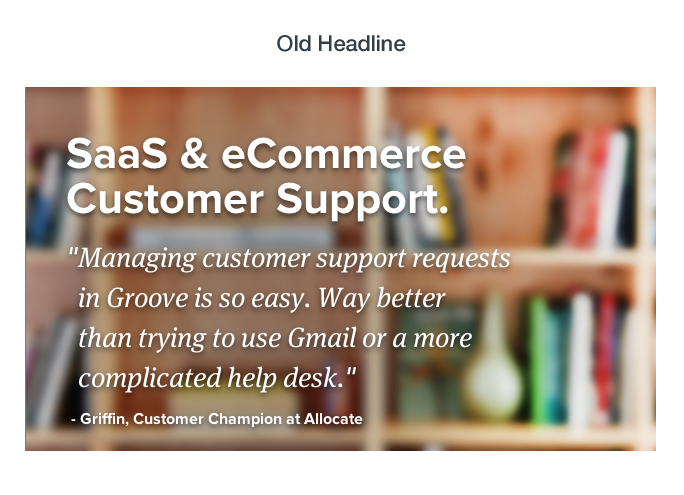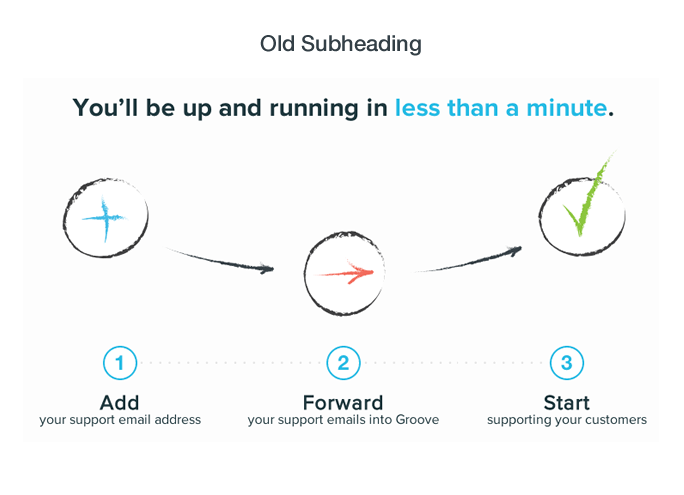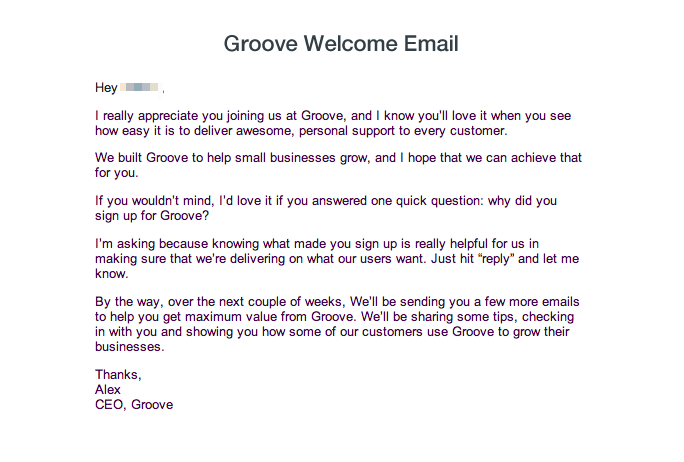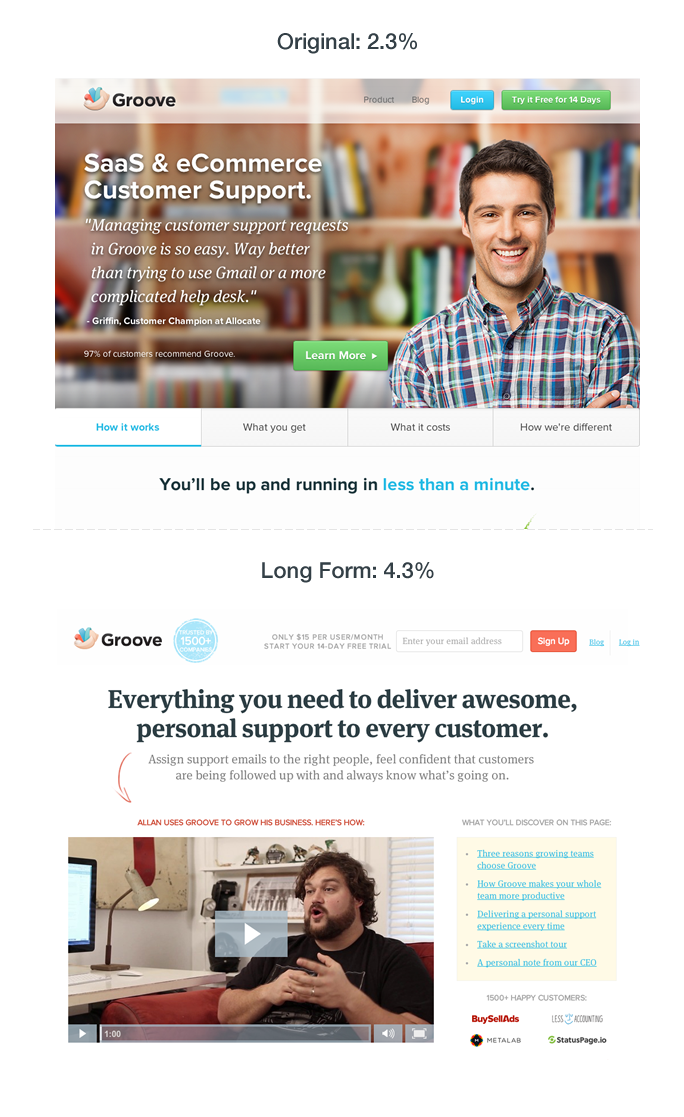How redesign helped increase conversion by 104%

“Our customers were happy, the product is great, and we had a terrible conversion in registration. That's what we did with that. ”
So begins the story of Groove founder Alex Turnbull.
Groove is a service for organizing the work of customer support (support management via chat, online surveys, trigger mailing, integration with social networks; analytics of calls and other chips).
')
On the product side, everything is cool: the service quickly gained several thousand users, many of whom did not want to hear about other options. Groove ideally got into the needs of the target audience - small companies that do not need "cool" functionality.
Easier to work, more personalized settings, 4.5 times cheaper than top competitors (Zendesk). Plus a great blog with a bunch of insights, and your own support became the benchmark for SaaS: project founder Alex Turnbull spent 500 (!) Hours negotiating with Skype customers to find out their needs, motives and expectations.
It would seem that something else to worry about, here it is - the market fit - the "assemblage point" of the product and the market. But…
One colleague said: “I’m surprised that you’ll even get any requests from the landing page.” Let's see what's terrible there.

Title: Customer Support for SaaS and e-Commerce.
User Review: “Groove is very easy to manage client requests. This is more convenient than Gmail or "heaped up" analogues.
Social proof: "97% of users recommend Groove"
CTA button - “Learn more”.
Alex Turnbull notes: “In fact, we are not the best solution for the majority of blog readers and those who came from different publics about startups. Creating valuable content does not mean selling. With a conversion of 2.3%, we would not last long. ”
5 things they did before redesign
Blind restructuring can kill the good that is and destroy the project. Groove already had a sad experience of redesign at an early stage, in which they “poured” $ 50,000 without much benefit. This time, the case was approached more thoughtfully.
1) Studied best practices
Alex and his colleagues read everything they could about design and optimization of landing pages. “Try to understand what works for others and why. Other people's cases will not work for you 1 to 1, but this knowledge will definitely come in handy. ”
2) Consulted with experts
To better understand the reasons for low conversion, Groove asked for feedback from 12 well-known experts - what they think about the site, based on their experience. Current figures are not reported. The responses are a cross between "a little awful" and "incredibly awful."
Here are the main notes.
Old title (“Customer support for SaaS and e-Commerce”):

Expert review: “Customer support is a product, not a problem. What problems are you solving? ”
Subtitle (“You’ll configure everything in less than 1 minute”):

Expert's opinion: “You sell me how easy it is to set everything up by not selling the solution itself”.
According to Alex, the critical mistake is to talk to customers in the language of marketers. They hate it. The correct approach is to use the exact expressions of the customers themselves.
3) Interviewed existing users
With the help of analytics, KISSmetrics “pulled out” the list of users who performed the most operations and ... no, did not begin to do polls with “yes or no” answers, send newsletters and other banal things.
Groove needed not analytics, but a lively response. Therefore, recorded the views of advanced users on the phone and Skype. Exactly what they like and what they don’t like in the service + how they describe it.
Four control questions:
- What problems did you want to solve when registering with Groove?
- What can you compare your user experience with?
- What was the start of work like?
- What was the “aha-moment” for you when you “fell in love” with Groove?
Part of the answers, specific quotes entered the content of the new site. Alex Turnbull advises: “Your customers can teach you the right marketing. And if they repeat the same things in reviews, it’s probably worth focusing on them. ”
4) Talk to new subscribers
This is necessary in order to more accurately define user triggers - why people decide to work with you. Feedback from new users allows you to simulate a value proposition. You do not invent it out of your head, but you hear first-hand what the audience needs, what is expected of you and what problems they hope to solve.
In addition, the company has a welcome mailing list. A new user receives a letter asking “Why did you subscribe to Groove?”:

Alex Turnbull asks to write a response to him personally, because it will help improve the functionality and customer service. In conclusion, “In the coming weeks, we will send several letters with cases that will help you to“ squeeze ”maximum benefit out of Groove.”
41% of subscribers responded to welcome email. According to the developers, this move had the strongest impact on the company's marketing. Interestingly, a week after the registration, the answers of new users shy away from the features in particular.
Therefore, immediate response “Subscribe - Welcome email” is extremely important, as long as the feedback is not “polluted” by practical experience. The task is to identify the trigger of attraction. Hold at the stage of work - this is another story.
5) Defined "Who we are and who we want to be"
These are self-asking questions answered by all Groove members. Here they are:
- What is our business for?
- What do we mean in the life of our customers?
- What do we believe in?
- What we do not believe?
- Who are our ideal customers?
- How do we want the client to perceive us?
- Who are we not suitable?
- How are we different?
Excellent approach - helps to clearly understand the values of the team and the direction of movement. In short, the mission of the project.
Design Design Copy-First
In previous cases, Groove went in a standard pattern: first aesthetics, then copywriting. That is, they first made a beautiful picture, and customized content for it. According to Alex, it was insane.
This time, they acted differently: first, they analyzed the responses of users and tried to write a “history” of the product by sketching a structure in Balsamiq:

The goal is to get the visitor of the page as close as possible to the Groove user experience, to make him “walk in our shoes” and experience all the benefits of the product.
Alex Turnbull says: “We wanted to make a website like a friendly conversation with a visitor. To do this, they wrote two separate stories related to the problems of our audience. Within each created dozens of copywriting options and value propositions in the title, from which 5 were selected for testing.
In the messages they focused not on the product, but on the real problems of the audience. They tied the benefits of Groove as a solution. We edited and rewrote almost everything until we were convinced that we have something worthy of incarnation. And only after that they began to design the project, having built as a result a copywriting layout. ”
Working page prototype:

As you can see, it turned out a huge "footcloth", especially in comparison with the source. On the first screen - a heading / subtitle with a value proposition, a customer video review + a list of features that await a visitor.
Then - a few text reviews with the announcement “We are doing customer support management better thanks to Groove, because ...” And each of the review authors explains what touches him most in working with Groove. The benefits of the product are the words of customers.
The third and fourth screens occupy the functional features and benefits of the service. Fifth - again a quote from a review (“Groove - like a breath of fresh air for support work”) + answers to frequently asked questions “What can I do in the program?”
And on the last screen - the amount of user benefits calling for a 14-day trial.
What is the result?
After 10 days, the first statistically significant results stunned developers: conversion in registration increased from 2.3 to 4.3%. At 87%, almost doubled (!)
Once again for comparing the original and the new version (first screen):

The new version of the message: "All you need to create great personal support for each client."
Over the next two weeks, the conversion tightened to 4.7%. Thus, the overall increase after redesign is 104%.
Groove does not stop at this. They continue to collect feedback from visitors to the landing page to find out the reason for the refusal of registration; they test headlines, subheadings, images and calls to action, and also launch a short landing page.
Alex Turnbull points out: “Product design and development are processes, not events. They continue as long as the business lives. There is always something to check and “screw up”.
“I challenge you, no matter what your position is. Try asking yourself the same questions. Answers can completely change your business. ”
Share your comments in the comments and what you think about all this.
Source: https://habr.com/ru/post/295642/
All Articles